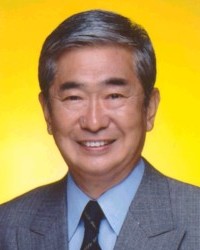
Back إيشيهارا شنتارو Arabic ايشيهارا شنتارو ARZ Ишихара Шинтаро BXR Shintarō Ishihara Catalan Shintarō Ishihara German Shintarō Ishihara Spanish Shintarō Ishihara Estonian شینتارو ایشیهارا Persian Shintarō Ishihara Finnish Shintarō Ishihara French
Shintarō Ishihara | |
|---|---|
石原 慎太郎 | |
 Kantei Public Affairs Office portrait c. 2003 | |
| Governor of Tokyo | |
| In office 23 April 1999 – 31 October 2012 | |
| Preceded by | Yukio Aoshima |
| Succeeded by | Naoki Inose |
| Minister of Transport | |
| In office 6 November 1987 – 27 November 1988 | |
| Prime Minister | Noboru Takeshita |
| Preceded by | Ryūtarō Hashimoto |
| Succeeded by | Shinji Satō |
| Director General of the Environment Agency | |
| In office 24 December 1976 – 28 November 1977 | |
| Prime Minister | Takeo Fukuda |
| Preceded by | Shigesada Marumo |
| Succeeded by | Hisanari Yamada |
| Member of the House of Councillors for National Block | |
| In office 8 July 1968 – 25 November 1972 | |
| Member of the House of Representatives for Tokyo 2nd district | |
| In office 10 December 1972 – 18 March 1975 | |
| In office 10 December 1976 – 14 April 1995 | |
| Member of the House of Representatives for Tokyo PR Block | |
| In office 11 December 2012 – 21 November 2014 | |
| Preceded by | Ichirō Kamoshita |
| Succeeded by | Akihisa Nagashima |
| Personal details | |
| Born | 30 September 1932 Suma-ku, Kobe, Japan |
| Died | 1 February 2022 (aged 89) Ota, Tokyo, Japan |
| Political party | Future Generations (2014–2015) |
| Other political affiliations | Liberal Democratic (1968–1973, 1976–1995) Independent (1973–1976, 1995–2012) Sunrise (2012) Japan Restoration (2012–2014) |
| Spouse | |
| Children | Nobuteru Hirotaka Yoshizumi Nobuhiro |
| Relatives | Yūjirō Ishihara (brother) Mie Ishihara (sister-in-law) Risa Ishihara (daughter-in-law) |
| Alma mater | Hitotsubashi University |
| Profession | Novelist and author |
Shintaro Ishihara (石原 慎太郎, Ishihara Shintarō, 30 September 1932 – 1 February 2022) was a Japanese politician and writer who was Governor of Tokyo from 1999 to 2012. Being the former leader of the radical right Sunrise Party, later merged with Toru Hashimoto's Japan Restoration Party out of which he split his faction into the Party for Japanese Kokoro,[1] he was one of the most prominent ultranationalists in modern Japanese politics.[2][3] An ultranationalist, he was infamous for his misogynistic comments, his xenophobic views and his racist remarks against Chinese and Koreans in Japan, including his use of the antiquated pejorative term "sangokujin".[4][5][6] He was also a denier of the Nanjing Massacre.[7][8]
Also a critic of relations between Japan and the United States of America, his artistic accomplishments included his authorship of a prize-winning novel, his authorship of best-sellers, and his work in theater, film, and journalism. His 1989 book, The Japan That Can Say No, co-authored with Sony chairman Akio Morita (published in English in 1991), called on the authors' countrymen to stand up to America.
After an early career as a writer and a film director, Ishihara served in the House of Councillors from 1968 to 1972, then, he served in the House of Representatives from 1972 to 1995, and then, he served as Governor of Tokyo from 1999 to 2012. He resigned from the governorship to briefly co-lead the Sunrise Party, then, he joined the Japan Restoration Party and he returned to the House of Representatives in the 2012 general election.[9] He unsuccessfully sought re-election in the general election of November 2014, and officially left politics the following month.[10]
- ^ Rydgren, Jens (2018). The Oxford Handbook of the Radical Right. Oxford University Press. pp. 772–773. ISBN 978-0190274559. Retrieved 2 August 2020.
- ^ Michiyo Nakamoto; Mure Dickie (21 March 2012). "China protests spur Japanese nationalists". Financial Times. Archived from the original on 10 December 2022. Retrieved 13 July 2021.
- ^ The Associated Press (17 November 2012). "Ex-Tokyo governor, mayor form own party for national election". CTV News. Retrieved 13 July 2021.
- ^ Mizuho Aoki (16 December 2014). "Controversial to the end, Shintaro Ishihara bows out of politics". The Japan Times. Retrieved 13 July 2021.
- ^ Kyodo (10 March 2001). "Ishihara slammed for racist remarks". The Japan Times. Retrieved 13 July 2021.
- ^ "Shintaro Ishihara: A politician who peddled hatred". 4 February 2022.
- ^ "David vs. Goliath: Resisting the Denial of the Nanking Massacre". The Asia-Pacific Journal: Japan Focus. Retrieved 3 October 2023.
- ^ Cite error: The named reference
:0was invoked but never defined (see the help page). - ^ "Ex-Tokyo Gov. Ishihara set to secure lower house seat". Archived from the original on 19 January 2013. Retrieved 19 December 2012.
{{cite web}}: CS1 maint: bot: original URL status unknown (link). Japan Times. 16 December 2012 - ^ 引退会見詳報 [Full Report of Retirement Press Conference] (in Japanese). 16 December 2014. Archived from the original on 12 October 2017. Retrieved 25 January 2016.
© MMXXIII Rich X Search. We shall prevail. All rights reserved. Rich X Search